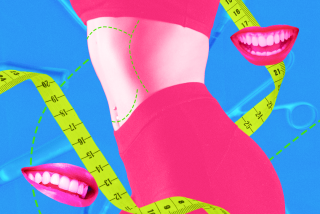‘Tis the Season for (Not) Eating
- Share via
I am the parent of a severely anorexic 16-year-old daughter. A few weeks ago, I wrote to the CEO of Neiman Marcus to express my outrage about the prominence of extremely underweight models in his store’s recent holiday catalog. I cut up and returned my credit card in protest. No one has responded.
In watching my beautiful and talented daughter waste away over the past couple of years, I have thought a great deal about eating disorders. I know something about how they affect people. Perhaps my family’s story will be of interest as we approach the holiday season when eating and drinking seem to take center stage.
I missed the early warning signals. Excuses like “I’ve already eaten; I’ll eat later; I don’t eat that anymore” were messages in a language I failed to understand. I interpreted the ever-present dirty dishes and food wrappers as evidence that she was eating, but in private. I did not know that anorexics frequently suffer from bulimia too. Loose clothing and modesty hid the fact that she was becoming dangerously thin. It wasn’t until she was too weak to go to school that I realized she had at least one and possibly two eating disorders.
My second mistake was thinking that once we were armed with a diagnosis, proper treatment and recovery were not far away. I quickly learned that traditional hospitals are ill-equipped to provide meaningful treatment for the typical anorexic. I learned that my insurance carrier specifically excludes this life-threatening disorder from its list of other, less pernicious obsessive-compulsive disorders for which it does provide benefits.
Anorexia and bulimia have had severe medical and social consequences for my daughter and significant economic and emotional impacts on our family. My husband and I have invested thousands of dollars in her treatment with no guarantee and only modest improvement. One thing is clear: There is no silver bullet, but there is hope--and a few things that are helpful to know. Parents should:
* Recognize the warning signals. The earlier the problem can be identified and addressed, the better the prospects for recovery are. If you think there may be a problem, educate yourself.
* Consult the experts. Your family doctor may be out of his or her depth in providing help. Don’t be afraid to ask them and others for referrals to respected specialists. There also are many independent and church-affiliated 12-step programs easily reached from most residential areas.
* Let go of outcomes. Helping anyone, especially your child, struggle with an eating disorder is a one-day-at-a-time thing. Your cherished strategies for their well-being will need to be adjusted. As painful as it is, your best assistance may not be helping your daughter get into the finest college, as you had imagined. It may be financing her second visit to a residential treatment center.
Certainly, it is far better not to get an eating disorder than to recover from one. I believe that advertising that features young, emaciated models in gorgeous, trendy clothing makes young women want to look like them. Many of these same young women will become self-conscious about their own bodies, some will become anorexic and a few will die.
Perhaps it is time for the department stores to give us a gift this holiday season. Stop featuring clinically underweight models. It’s time for the fashion community to make a sizable donation to a hospital dedicated to the treatment of eating disorders. For my part, I will vote with my pocketbook and not shop where advertising features emaciated models.
More to Read
Eat your way across L.A.
Get our weekly Tasting Notes newsletter for reviews, news and more.
You may occasionally receive promotional content from the Los Angeles Times.










